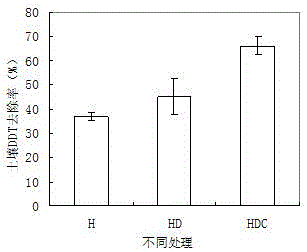Method and application for remedying DDT-contaminated soil through plant-microorganism combination
A technology for combined restoration of polluted soil, applied in the field of polluted environment restoration, can solve the problems of high cost, incomplete removal, secondary pollution by chemical methods, etc., and achieve the effect of ecological and environmental protection removal
- Summary
- Abstract
- Description
- Claims
- Application Information
AI Technical Summary
Problems solved by technology
Method used
Image
Examples
Embodiment Construction
[0028] Below by example the present invention is described in further detail. The test methods in the following examples, unless otherwise specified, are conventional methods, and the test materials used, unless otherwise specified, are purchased from the conventional biochemical reagent market.
[0029] A method and application of plant-microbial joint restoration of DDT-contaminated soil, using three schemes for restoration experiments and comparisons on DDT-contaminated soil;
[0030] The three options mentioned are
[0031] Option 1: plant ryegrass alone to remediate DDT-contaminated soil, as a reference group, denoted by H;
[0032] Scheme 2: Add DDT-degrading bacteria to plant ryegrass to restore DDT-contaminated soil, as a control group, expressed in HD;
[0033] Scheme 3: Add DDT-degrading bacteria and plant rhizosphere growth-promoting bacteria to plant ryegrass to restore DDT-contaminated soil, as a control group, represented by HDC.
[0034] The method and applic...
PUM
 Login to View More
Login to View More Abstract
Description
Claims
Application Information
 Login to View More
Login to View More - R&D
- Intellectual Property
- Life Sciences
- Materials
- Tech Scout
- Unparalleled Data Quality
- Higher Quality Content
- 60% Fewer Hallucinations
Browse by: Latest US Patents, China's latest patents, Technical Efficacy Thesaurus, Application Domain, Technology Topic, Popular Technical Reports.
© 2025 PatSnap. All rights reserved.Legal|Privacy policy|Modern Slavery Act Transparency Statement|Sitemap|About US| Contact US: help@patsnap.com



